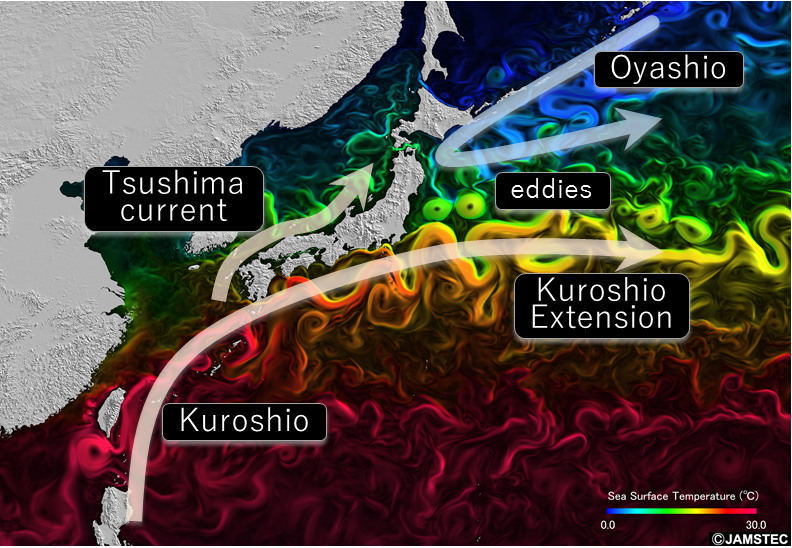Project overview
Purpose of the Research Project
Frequency of extreme rainfalls and snowfalls has been increasing these years, and those events severely affect
human lives and properties.
It has been considered that tropical ocean and atmosphere variability such as El Niño, as well as the
warming climate, remotely influences mid-latitude extreme weather/climate, while the mid-latitude ocean is
passive to atmospheric variability. Current operational seasonal climate predictions are conducted based on
this climate “assumption.”
Recent high-resolution ocean/atmospheric data analyses, however, have revealed that mid-latitude ocean also
influences atmospheric circulations and their variability. Rediscovering strong warm current (e.g., the
Kuroshio and the Gulf Stream) and associated strong ocean frontal zones as “climate hotspot”, we have
elucidated mechanisms of ocean-atmosphere interactions and established a new paradigm of active roles of
mid-latitude oceans in the climate system, replacing the conventional “assumption.”
The research progress has prompted a new crucial task: application of such new knowledge to predictions of
extreme rainfalls/snowfalls and climate variability. In the present project, I) we will further our
understandings of mid-latitude ocean-atmosphere interaction processes that span multiple spatio-temporal
scales and interplay among them through tight collaborations of latest observational and numerical
modeling tools. Also, based on the improved understandings, II) we investigate predictability of
extreme weather (such as typhoons and bomb cyclones), of persistent atmospheric circulation anomalies
that induce those extremes, projection of climate changes, and active roles of mid-latitude oceans
in those phenomena.The purposes of the present project are then deepening of the previously established
paradigm and showing its scientific and societal importance and validity.

Ocean currents and temperature around Japan
Content of the Research Project
For I), we conduct an intensive observational campaign of both atmosphere and ocean in the Tsushima warm current
region located upwind of Japan with directly impacts on its climate, utilizing state-of-the-art observational
equipment. We further expand our understanding of ocean-atmosphere interactions with their linkage to
atmospheric substances through investigations of impacts of heat and aerosols exchanges between
ocean and atmosphere on low-level clouds and marine ecosystems.
For II), our studies will extend to evaluations of potential improvements of prediction and/or uncertainty of
disaster inducing atmospheric circulation anomalies and extreme rainfall/snowfall, by considering
active influences from mid-latitude oceans. Also, we will try to obtain general understandings of
roles of climate hotspot under the changing climate and its impacts on uncertainty of climate change projection.
Expected Research Achievements and Scientific Significance
Three achievements are expected: 1. Further deepening of our understandings of multi-scale ocean-atmosphere interactions and their mechanisms. 2. Evaluations of possible contributions of ocean-atmosphere interactions in climate hotspot and especially ocean’s active roles onto improvements of predictability of extreme rainfall/snowfall, extreme weather events such as typhoon and bomb cyclones, and persistent atmospheric circulation anomalies associated with extreme climate. Also, estimations of predictability of ocean currents and eddies, which induce ocean temperature variability. 3. Basic and general knowledge on overlooked roles of mid-latitude air-sea interactions for the warming climate. This will make the first estimation of uncertainty of climate change projection caused by mid-latitude ocean-atmosphere interactions in climate projection models. Through these developments in the fields of predictability and global warming, wide societal impacts are expected from the present project.













